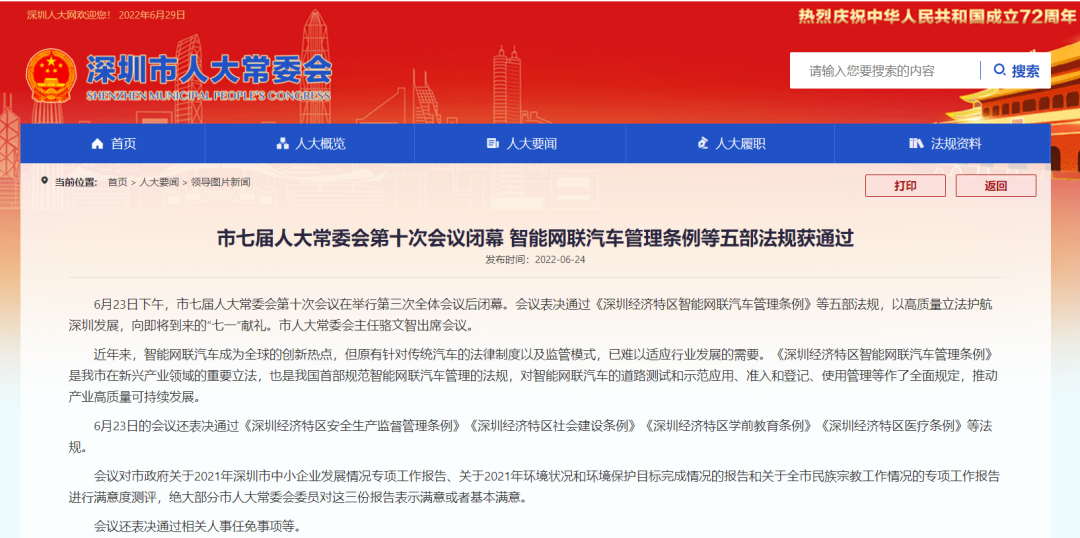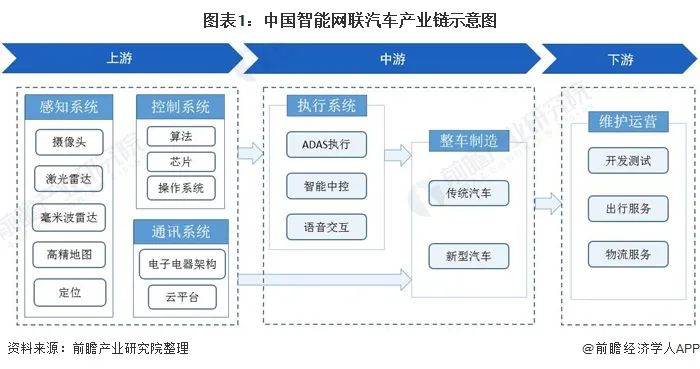On June 23, the Regulations on the Administration of Intelligent and Connected Vehicles of Shenzhen Special Economic Zone (hereinafter referred to as the Regulations) was approved by the 10th session of the Standing Committee of the 7th Municipal People's Congress. The passage of the regulations means that driverless cars will be legal on the roads in Shenzhen. As China's first regulation regulating the management of intelligent and connected vehicles, this breakthrough legislation fills the legislative gap related to autonomous driving and attracts great attention in the industry.
01 Smart connected vehicles and L3 level autonomous driving definition
The regulations gives the clear definition of smart connected vehicle, namely: refers to carrying advanced vehicle sensors, controller, actuator device, and integrating modern communication and network technology, car to car, road, people, cloud, intelligent information exchange, sharing, with complex environment perception, intelligent decision-making, collaborative control and other functions, can achieve safe, efficient, comfortable, energy saving, and eventually can realize alternative operation of a new generation of cars.
For intelligent and connected vehicles, autonomous driving is divided into three technical levels: conditional autonomous driving, highly autonomous driving, and fully autonomous driving.
The L3 level of autonomous driving refers to that the autonomous driving system can perform all the dynamic driving tasks within the designed operating conditions, and the driver can perform the dynamic driving tasks in an appropriate way. (That is, you can have your hands off the steering, but you need to take over anytime if necessary.)

02 The significance of the Regulations
In recent years, intelligent and connected vehicles have become a global innovation hot spot. The original legal system and regulatory model for traditional vehicles have been difficult to meet the needs of the industry development. In order to accelerate the technological iteration, the call for autonomous driving legislation has been very high. Around the world, major auto powers are also actively paving the legal way for the development of autonomous driving. For example, as early as 2017, German lawmakers passed legislation on L3 autonomous driving. Late last year, Germany's Federal Motor Transport Authority (KBA) approved Mercedes's L3-level autonomous driving system. In 2021, Japan also released the Measures report and Guidelines for the Implementation and Popularization of Autonomous Driving to promote the implementation of autonomous driving, while the U. S. Department of Transportation formulated the Comprehensive Plan for Autonomous Vehicles.
As the first regulations regulating the management of intelligent connected vehicles in China, the Regulations mainly make comprehensive provisions on the road testing and demonstration application, access and registration, and use management of intelligent connected vehicles.
The Regulations clearly stipulate that intelligent and connected vehicles can be driven on the special zone roads after obtaining registration and obtaining registration certificates, license plates and driving permits. The Regulations are also the first relevant document in China to detail the rights, responsibilities and definitions of autonomous driving in L3 and above, removing policy obstacles for models that have already achieved autonomous driving conditions on the road. And this is also the biggest highlight of the regulation, which supports the overall traffic of L3 level autonomous driving in the previous grey area, including high-speed, urban open roads and parking areas, as well as the liberalization of commercial operations.
Experts said that after the implementation of the regulations in Shenzhen, other autonomous driving pilot cities are likely to learn from their experience to quickly promote the development of the autonomous driving management mechanism and industries in the region. At the national level, national legislation related to autonomous driving will also be timely promoted according to the development of autonomous driving pilot cities.
03 Voyager Technology how to welcome unmanned driving

(The intelligent and connected automobile industry chain includes upstream key systems, midstream system integration and downstream application services.)
According to the intelligent connected vehicle technology roadmap guidelines released by the World Intelligent Connected Vehicle Conference at the end of 2020, it is expected that L2 to L3 vehicles will account for 50% in 2025, L 2 to L3 vehicles will account for more than 70% in 2030, and L4 and above vehicles will account for 20%.
L3 and above grade autonomous driving vehicles generally need sensing (vision, lidar, 4D millimeter-wave radar), computing (domain controller, high computing power chip), execution (drive by wire chassis) and other aspects of support. With the implementation of relevant laws and regulations, the increased penetration rate of domestic L3 + autonomous driving will drive the overall technology upgrading of the industrial chain and the growth of parts demand, the penetration rate of intelligent connected vehicles will accelerate, and the upstream and downstream enterprises of the industrial chain will fully benefit from the demand expansion brought by technological upgrading.
Voyager Technology has been focusing on the field of intelligent travel for nearly 10 years. It has laid out in multiple links of the industrial chain, deeply engaged in the fields of environmental perception, intelligent decision-making, control and execution, covering the full-stack technical capabilities of hardware, software, algorithm, sensors and intelligent cockpit, and autonomous driving system integration required for autonomous driving.
As one of the key technologies in the industrial chain, Voyager Technology has deep cooperation with many domestic and foreign OEM production projects, for autonomous driving solutions, autonomous driving engineering ability, hundreds of thousands of real car perception data and closed-loop system, continuous optimization of perception algorithm and models, implementation and calibration on many car models.
Adhering to the corporate mission of "for automotive and beyond, make driving easier", Voyager Technology is committed to promoting the accelerated arrival of high-level intelligent driving solutions, and helping to promote the large-scale mass production and market application of L2~L3 autonomous driving. In 2023, the L3 level "VT-Pilot2.0 autonomous driving system" will be launched, covering perception, integration, regulation control to intelligent driving domain control, cross-domain integration of driving and parking integrated solution, continue to deepen the field of smart driving, and continue to empower the development of smart connected vehicles.






